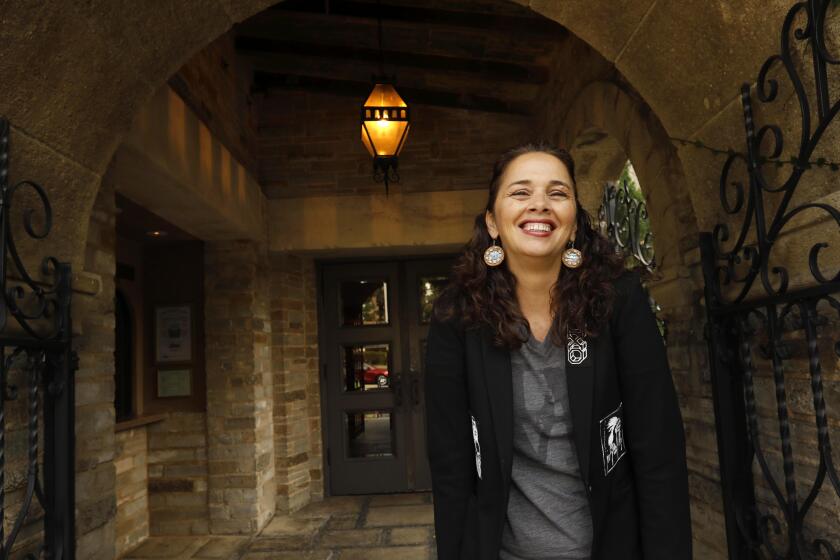‘All the Living,’ by C.E. Morgan
People Are Unappealing
True Stories of Our Collective
Capacity to Irritate and Annoy
Sara Barron
Three Rivers Press: 224 pp., $13.95 paper
These days, the market is pretty well saturated when it comes to memoir. Which means it has to be good; it has to be different. Sara Barron’s essays about her childhood, her parents, her life in acting school in Manhattan and her fellow actors are, dare we say it, as funny as David Sedaris’. “Listen to the lyrics,” her heterosexual, musical-loving father who writes dictionary definitions for a living tells Sara and her younger brother, Sam, at the dinner table. “ ‘It’s a song about chasing your dreams. I hope you both chase your dreams. . . .’ ‘Dad’s a homo!’ Sam would shout. ‘He cries like a homo!’ ‘Your father’s not gay,’ my mother chimed in. ‘He’s effeminate.’ ‘Oh, I’m gay,’ my father countered. ‘Who here knows what gay really means?’ ”
Barron is appalled to learn how much, as a young adult, she resembles her grandmother: “I live alone and I own a laughable number of house plants. I’ve named them all after characters in my favorite romance novels.” After getting her bachelor’s degree in acting, Barron works here and there as a stand-up comic and spends too much time in minimum-wage jobs dating other out-of-work actors. All of the essays contain some sexual awkwardness (her father’s bold femininity, an actress friend’s inability to live in the predominantly gay world of theater and film without her needed quota of male attention). Barron swats these quirks around like a cat with a big, juicy catnip toy. When you aren’t squirming, you’re laughing out loud.
All the Living
A Novel
C.E. Morgan
Farrar, Straus & Giroux: 200 pp., $23
This is a book about life force, the precious will to live and all the things that can suck it right out of a person. It is a first novel, and the writing is simply astonishing: The way small movements betray a character, the effects of hard labor, the damaging power of communication withheld. It is the writing of a much older (at times, even world-weary) author. Descriptions of the landscape of the rural South remind a reader of Willa Cather. The characters’ utter lack of a sense of entitlement calls to mind Charlotte Brontë’s “Jane Eyre.”
The young woman, Aloma, an orphan, follows her lover, Orren, a tobacco farmer whose remaining relatives have just been killed in an accident, to live and work the family farm. It is a daunting place, the South of Harper Lee and Carson McCullers. “The house cast no shadow in the bare noon light.” Aloma is a talented pianist; she has been teaching piano at the boarding school her aunt and uncle sent her to. She knows nothing of farming or housekeeping or cooking. The old piano in the farmhouse is too far gone to play -- Aloma takes a job as pianist at the local church. The preacher there fills the gaps created by Orren’s inability to share his work and his fears with Aloma.
“All the Living” has the feel of Terrence Malick’s “Days of Heaven.” Like that film, the novel does beautiful justice to the havoc that exhaustion can wreak in a life. Everything lives in this writing; the wood floors “ached and sounded under her,” the dust rolls and sweeps “low to the ground in blond curls behind his truck, then flanging and fading to nothing,” the place she grew up was a “chasmed world without the twin ceremonies of morning and evening.” C.E. Morgan is clearly familiar with the attenuated dialogue of the South. She uses words you hardly ever see anymore; words like “hasp.” Aloma’s continued love for Orren in spite of his brusque behavior is inexplicable (“she liked his bookless voice and the way his vowels clung to the back of his throat”), and it is sorely tested. How is it possible for a young writer to know so much about self-sacrifice?
One D.O.A.,
One on the Way
A Novel
Mary Robison
Counterpoint: 176 pp., $23
Location scouts are a busy bunch, so Eve’s distraction, her inability to get her intern’s name right, her lack of concern over her husband’s life-threatening illness, all seem plausible. She is a woman caught in the cross hairs of a gothic New Orleans family, and she is not exactly up to the challenge. Like her creator, however, Eve has her ear to the ground; the fragments she picks up become characters in a rip-roaring puzzle of a plot. Saxophone music on a hot night, streetcars and trauma centers, “a man carrying a wire birdcage. New Orleans is full of meanings I haven’t learned. I’ve had many of them explained to me, but the words didn’t get through. I still don’t understand.”
More to Read
The biggest entertainment stories
Get our big stories about Hollywood, film, television, music, arts, culture and more right in your inbox as soon as they publish.
You may occasionally receive promotional content from the Los Angeles Times.






